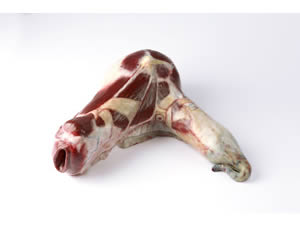
Simone Racheli

Plastica, cartapesta, cera, 25 x 26 x 11 cm
Courtesy Paolo Maria Deanesi Gallery, Rovereto
Le sculture di Simone Racheli, dislocate nel primo piano del Castello, indagano le reti organiche dei tessuti muscolari e ciò che sta all’interno di esse (reti sanguigne, reti di irrorazione, etc.). Racheli parte da oggetti presenti nella realtà quotidiana (quali poltrone, scope, ferri da stiro, appendiabiti, frullatori, spazzole, ma pure estintori, lavandini, termosifoni) la cui meccanica evoca la funzionalità di un organo o la motilità di un arto del corpo umano.
Questi oggetti, una volta prelevati dal contesto originario, vengono rivestiti da strati di cera successivamente intarsiata e pigmentata in maniera tale da apparire come stratificazioni di tessuto muscolare. Se l’oggetto non si presta a questo processo, lo scultore ne ricostruisce la sagoma con della rete metallica, la riveste di cartapesta e gesso, infine completa l’opera con la cera grezza.
Ciò che appare allo spettatore è la messa in scena di corpi impossibili, di oggetti comuni dalla fisionomia organica, familiari come la carne scorticata pronta per essere venduta e al tempo stesso estranei essendo manipolazioni golemiche atte a simulare la funzionalità di un fascio muscolare. L’operazione di Racheli, pertanto, non si limita alla mera apposizione di superfetazioni di materia sviscerata attorno all’oggetto inanimato per farlo comparire animato, ma crea dei prototipi corporei che paiono una sorta di fase embrionale dell’essere.
Simone Racheli’s sculptures, placed in the first floor of the Castle of San Vito al Tagliamento, investigate the organic net of muscle tissues and what is inside of them (for exemple, blood-vessels). Racheli starts from everyday objects (as armchairs, brooms, steam irons, mixers, hairbrushes, fire extinguishers, washbasins, heaters), whose mechanism evokes organ’s functions or the motility of human body’s limbs. These objects, once withdrew from their original context, are covered with strata of wax; afterwards, the wax is inlaid and pigmentated to look like layerings of muscle tissue. If the object is not proper for this process, Racheli reconstructs its shape, covers it with papier-mâché and plaster, then completes the sculpture with wax. He uses wax for two reasons: the wax can render complexion’s depht (painting can’t do it with the same mimesis); secondly, he continues the tradition, started in the eighteenth century, of the use of wax for three-dimensional anatomical models, made for medical practice. What finally appears to the spectator is a set-up of impossible bodies, of everyday objects with an organic physiognomy, as familiar as flayed meat and at the meantime strange because they are golemic handlings that simulate the function of a muscle bundle. Racheli’s operation isn’t just a mere apposition of superfetation of matter around a lifeless object to make it appearing animate, but it creates bodily propotypes that look like a sort of embryonic being.



